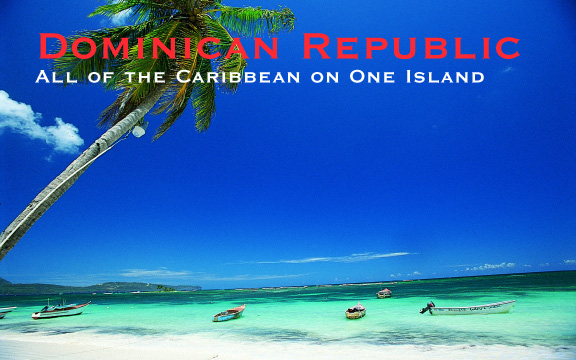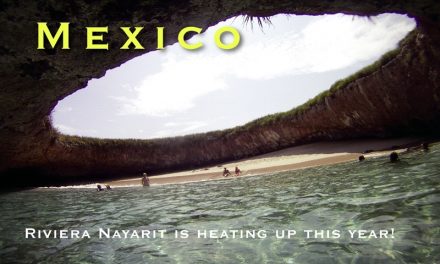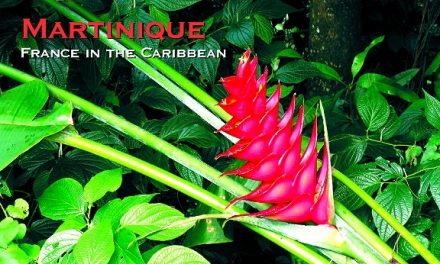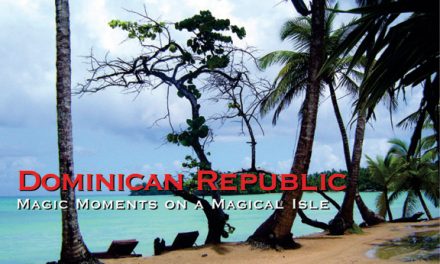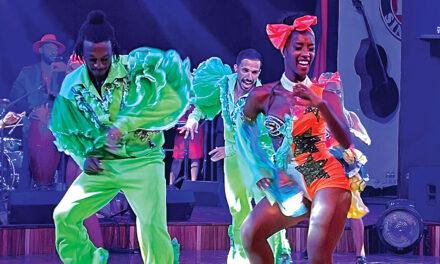Dominican Republic
All of the Caribbean on Just One Island
Published in the January, 2004 Issue of Canadian World Traveller
Photos Courtesy of Dominican Republic Tourist Board www.dominicana.com.do
In the heart of the Caribbean, bathed by the waters of the Atlantic Ocean on its North Coast and the Caribbean Sea to its South, is the island nation of the Dominican Republic. It consists of the eastern half of the island of Hispaniola, which Christopher Columbus discovered on December 5th, 1492, during his first voyage to the New World. When Columbus spotted the coral-rimmed island, he proclaimed, “This is the fairest land under Heaven.” The Dominican Republic offers some of the most beautiful beaches in the world, but it is also home to the highest mountain range in the entire Caribbean. Its capital city of Santo Domingo, with its quaint cobble-stoned streets and stonework buildings, owns the claim as the oldest city established in the New World.
This beautiful island nation is steeped in history and culture worthy of exploring: abundant historical sites, museums, colonial architecture, the first hospital, first sugar mill, and the first Catholic church on this side of the Atlantic. Visitors will soon discover that the Dominican Republic offers much more than the typical Caribbean destination attractions of sun, sand and sea.
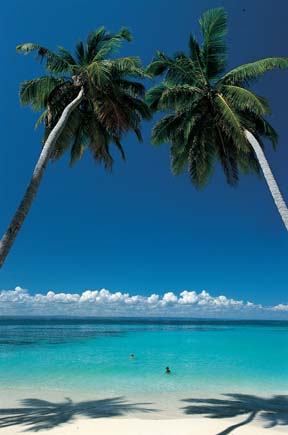 The Coastline
The Coastline
The Dominican Republic occupies some 48,442 sq. km of the 76,192 sq. km it shares with the neighbouring Republic of Haiti. Its natural beauty and rich history delight and impassion those who get to know it. Over 300 km of idyllic sand beaches mark the country’s dramatic coastline.
This makes it difficult to choose from the calm, shallow tides of Boca Chica; the multi-coloured waters of Juan Dolio-Guayacanes; the postcard-perfect beaches of La Romana and Bayahibe; the pearl-white sands of Punta Cana, Bavaro and Macao; the inviting soft waves of Las Terrenas, Portillo and Cayo Levantado; the exhilarating Atlantic currents of the northern beaches of Cofresi, Playa Dorada, Playa Grande, Sosua and Cabarete; or the untamed beauty of the southwest’s beaches of Barahona and beyond.
The wide diversity of beach-front resorts explains in part the high repeat rate of visitors to the Dominican Republic, where no two beaches are alike.
Topography, Climate & Population
The country’s topography is generally rugged and mountainous, dominated by four parallel mountain ranges extending in a northwesterly direction. Most of its eastern region is characterised by steep valleys and lowland plains. Though many of the nation’s numerous rivers are too shallow for navigation, they are an important source of water and hydroelectric power.
The Dominican Republic has two rainy seasons, one in the late spring and one in the fall, with the heaviest precipitation in the northern and eastern parts of the country. With five variations or microclimates, classified as: humid, dry steppe, tropical jungle, forest, and savanna, the average annual temperature fluctuates between 18°C and 27ºC. For Dominicans there is only one season: Summer.
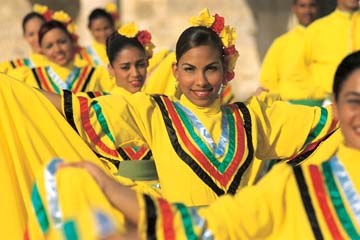 The country has three major metropolitan areas. The capital Santo Domingo, with a population of two million people; Puerto Plata with some 60,000 year-round residents and Santiago, with a population of well over quarter a million inhabitants. Sosua, near Puerto Plata, and La Romana and Punta Cana, at the eastern end of the island, all have growing resort populations. The rest of the nation’s six million plus population live in smaller towns and villages.
The country has three major metropolitan areas. The capital Santo Domingo, with a population of two million people; Puerto Plata with some 60,000 year-round residents and Santiago, with a population of well over quarter a million inhabitants. Sosua, near Puerto Plata, and La Romana and Punta Cana, at the eastern end of the island, all have growing resort populations. The rest of the nation’s six million plus population live in smaller towns and villages.
The island of Hispaniola was originally inhabited by an estimated one million Indians who were annihilated in less than a century by the Spanish conquerors. Today, 70 percent of the Dominican Republic’s population are mulattos, the result of extensive intermingling between white European settlers and African slaves. The remaining 30 percent are white, black and Asian.
Government, Language & Religion
The government of the Dominican Republic is a representative democracy governed by a President and Congress formed by 30 senators and 149 House Representatives elected directly every four years.
Spanish is the official language of the country and street signs and restaurant menus are written in the mother tongue. Even though people serving to the tourist trade generally speak English, knowing some Spanish is a great advantage. It is important to point out that “Dominicanese” (the local way of speaking Spanish) evolved from the everyday life experience of the peasant and is expressed with a unique accent and flavour. As in all countries, each region has its charm and accentuates its expressions in a peculiar way, identifying the speaker from the first words uttered in his conversation.
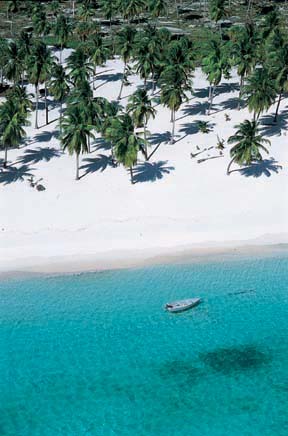 In the Dominican Republic, freedom of worship is established in the Constitution. According to the latest census results, the predominant religion group is Roman Catholic with 95% of the population. The the first Catholic Archdiocese in the Americas is located in Santo Domingo.
In the Dominican Republic, freedom of worship is established in the Constitution. According to the latest census results, the predominant religion group is Roman Catholic with 95% of the population. The the first Catholic Archdiocese in the Americas is located in Santo Domingo.
History & Culture
In 1492, Christopher Columbus landed on the island and encountered its inhabitants, a then unknown race of Indians called Tainos, which in the arawak language means good or noble. The Tainos had lived on the island since 800 A.D. Their way of life was simple but rich in religious and agricultural traditions. However, the discovery and conquest of the island exterminated this race in a period of approximately 50 years, limiting the impact of the indigenous Indian culture on present-day Dominican life.
With the establishment in the year 1492 of the first Fort on La Española, the name given to the island after its discovery, the island started a trans-cultural process which defines the present-day Dominicans, the offspring of the Spanish conqueror and the African slave, with a drop of Indian blood in the background.
La Hispaniola was the first European colony of the New World, and in it’s capital city, Santo Domingo, also called First City of the Americas, one finds the first American colonial institutions: the first fortress, the first first cathedral, the first hospital, the first monuments and the first university.
At the end of the 16th century, La Hispaniola was known for its mineral abundance and its sugar cane plantations. However, when the gold mines were emptied, there was a massive exodus of the population of the colony. French buccaneers, who used the island as a contraband bridge, took advantage of this situation to invade and expropriate the western part of the island where they founded the colony of Saint Domingue (present-day Haiti), based on the exploitation of plantations using African slaves.
From 1697 onwards, Spain and France fought to dominate the whole island, but in 1844, a group of Dominican patriots headed by Juan Pablo Duarte, proclaimed the independent State of Dominican Republic on the eastern half of the island. A brief new annexing by the Spanish crown (1861-1863) ended with the War of Restoration and the re-establishment of today’s independent Republic.
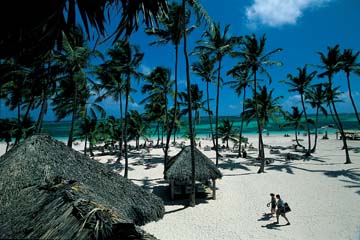 Cuisine, Music & the Arts
Cuisine, Music & the Arts
The Dominican Republic is considered the “Breadbasket of the Caribbean,” where much of what is served at the dinner table is grown, farmed or, in the case of its seafood, caught domestically. That includes everything from the kiwi fruits and strawberries grown in the fertile Cibao Valley to the lobster, mahi-mahi and swordfish abundant in the waters of the Caribbean Sea.
What the locals do with the food is what makes it so flavourful. Comida criolla (Dominican cuisine) is generally hearty fare with ingredients and cooking methods derived from Spanish, African and Taino cultures. Typical dishes known as La Bandera (the flag) consist of the colours of the Dominican flag: white rice, red beans, stewed meats, salad and tostones (fried green plantains). Rice is the staple food, and it can be served more ways than one could possibly imagine. Creole cooking is probably the best way to define the seasonings and spices, but the food generally lacks the extreme spiciness people associate with North American Creole cooking. Of course there’s the world-famous Dominican rum. Buen provecho!
Of all the rhythms that enrich Dominican folklore, the merengue is the most popular. Everyone who hears a merengue vibrates to the contagious rhythm of the güira, the tambora (small drum), and the accordion. The güira consists of a grater made of latten brass in the shape of a hollow cylinder that when rubbed with a scraper, emits a buzzing rhythmic sound and the tambora owes its peculiar sound to having on one side, the skin of an old male goat, tempered with native rum, and on the other, the skin of a young female goat.
While visiting the island’s many art galleries, you can discover authentic native art which is not the pseudo-primitive art that abounds in other Caribbean islands. And if your stay in Santo Domingo coincides with the theatre season, try to attend a performance at the 1,700-seat Teatro Nacional in the heart of Plaza de la Cultura and enjoy a Dominican or international spectacle.
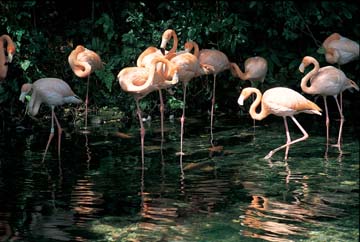
Getting There
More than 60 charter airlines fly to the airports of Santo Domingo, Puerto Plata and Punta Cana. Air Santo Domingo, a National airline, offers daily internal flights between the main airports of the country.
When to Go & What to Wear
The Dominican Republic is a year-round destination. Due to the tropical climate, it is advisable to bring a wardrobe of natural fibres such as cotton or linen. Regardless of the season, include a bathing suit, sun protection, sunglasses and a loose, comfortable dress or white suit for evenings.
Visas & Vaccination
Canadian visitors to the Dominican Republic require a passport valid for at least six months beyond the intended date of departure, a return or onward ticket, and a tourist card for visits of up to 60 days. The tourist card, which costs $10 US and can be purchased at accredited Dominican Consulates worldwide, when purchasing ticket, or on arrival at one of the country’s ports or international airports. There are no vaccinations required for Canadian citizens.
Where to Stay
A comprehensive listing of accommodations to suit every budget, sponsored by the Dominican Republic National Association of Hotels and Restaurants, is posted on the website DominicanRepublic.com.
Getting Around
Privately owned air-conditioned buses, such as those operated by Metro Buses and Caribe Tours, make regular runs to Santiago, Puerto Plata, and other destinations. One-way bus fare from Santo Domingo to Puerto Plata is about $6 US, and the trip takes four hours.
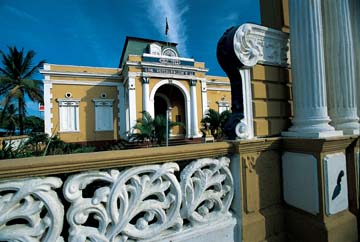 Historical Points of Interest
Historical Points of Interest
Santo Domingo boasts many historic edifices including the Alcazar de Colon (Columbus’ Palace), built by Don Diego Columbus in 1510; the Cathedral of Santa Maria, which Pope Paul III pronounced as the first cathedral in the New World; La Torre del Homenaje (The Tower of Homage), the oldest military construction in the New World, which served as a prison until the 20th century; and Las Ruinas del Monasterio de San Francisco (The San Francisco Monastery Ruins), which is the oldest monastery in the New World.
Also of interest is the Casa de Cordon (The Cord House), the first Spanish-style home built in the Americas, which was erected by conquistador Francisco de Garay. Surrounding the building was a beautiful gate trimmed with a cord resembling those used used by San Franciscan monks. Today it is a cultural centre sponsored by Banco Popular.
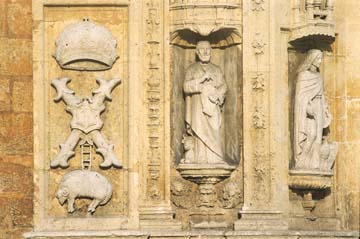 Santo Domingo boasts 10 museums, ranging from The Amber Museum of Puerto Plata, set in a Victorian mansion, and featuring a large array of prehistoric amber-encased specimens to The Museum of Taino Art, providing insights into the people who first inhabited the Dominican Republic.
Santo Domingo boasts 10 museums, ranging from The Amber Museum of Puerto Plata, set in a Victorian mansion, and featuring a large array of prehistoric amber-encased specimens to The Museum of Taino Art, providing insights into the people who first inhabited the Dominican Republic.
A notable landmark, Columbus’ Lighthouse is a towering structure in the form of a cross which was constructed to commemorate the 500th anniversary of the discovery of America in 1492. It houses the explorer’s remains, museums and exhibits donated by several countries. The edifice’s 151 light beams can be seen 40 miles away.
Water & Land Activities
With more than 1,288 km of coastline, the Dominican Republic boasts the most beautiful beaches of the Caribbean. Here, you will find white sandy beaches, diving attractions and unspoiled nature all around the island, offering scores of water sports activities, including windsurfing, snorkelling, parasailing, sailing, scuba diving, deep sea fishing and much more.
On land, you can enjoy spectacular golf courses, tennis, polo, horse back riding, shooting and cycling, river rafting and baseball, the national passion of the Dominican Republic.
Festivals and Events
It’s difficult to imagine in the Caribbean, a Carnival with much life, rhythm and so much colour as that of the Dominican Republic. Its major intensity and apogee take place at the end of the month of February, especially during the last week of this month and even in the first week of March.
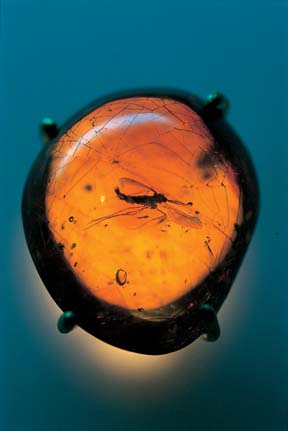 Nightlife
Nightlife
From 4 pm to 4 am (weekends until 6 am), excitement, high stakes and the thrill of winning awaits the spin of the wheel, the roll of the dice and the draw of the cards. The casinos of over 20 hotels, located in Santo Domingo as well as on the north, south and east coasts, offer Las Vegas-style action featuring blackjack, craps, roulette, poker, baccarat and clinking, blinking slot machines. Players must be over 18 years of age.
Shopping
The Dominican Republic is full of temptations for those who love to shop. Amber is one of the most important purchases that you could ever make on the island, as well as the Larimar, a semi precious stone of a light blue colour. For those who love art, you can find many mahogany sculpture for a very convenient price. A variety of native craft boutiques can be found scattered throughout the city’s business areas and shopping centres.
Currency & Exchange
The Official Currency of the Dominican Republic is the Peso, which fluctuates freely against the US Dollar and other foreign currencies. Currency exchange services are offered by most banks or private exchange houses (Casa de Cambio). Banking hours are from 8.30 am to 5 pm, Mondays to Fridays.
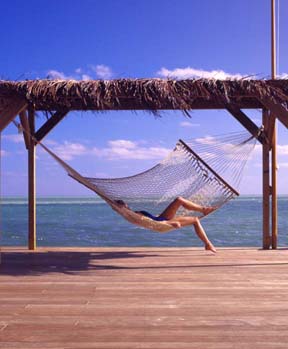 For More Info:
For More Info:
Dominican Republic Tourist Board
2080 Crescent Street,
Montreal, QC H3G 2B8
Tel.: (514) 499-1918
Toll Free: 1-800-563-1611
Fax: (514) 499-1393
E-mail: Montreal@sectur.gov.do
www.dominicana.com.do
www.dominicanrepublic.com
Dominican Republic Embassy (Canada & US)
1715 22nd Street NW
Washington, D.C., 20008, USA
Tel.: 202-332-6280
Fax: 202-265-8057
Email: embdomrepusa@msn.com
www.domrep.org
Dominican Republic Consulate (Montreal)
1470, rue Peel, Bureau 263
Montréal, QC H3A 1T1
Tel.: (514) 284-5455
Fax: (514) 284-5511
E-mail: raquel.jacobo@consulado-dominicano.com
www.consulado-dominicano.com
Air Santo Domingo
www.airsantodomingo.com.do (Under Construction)
http://airlines.priceline.com/airlines/air-santo-domingo.html

